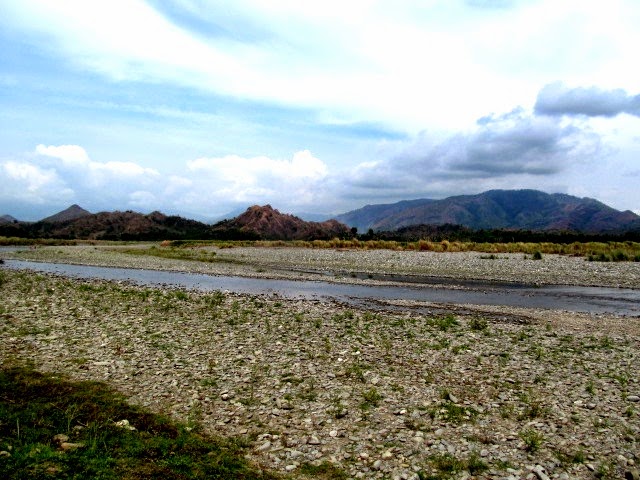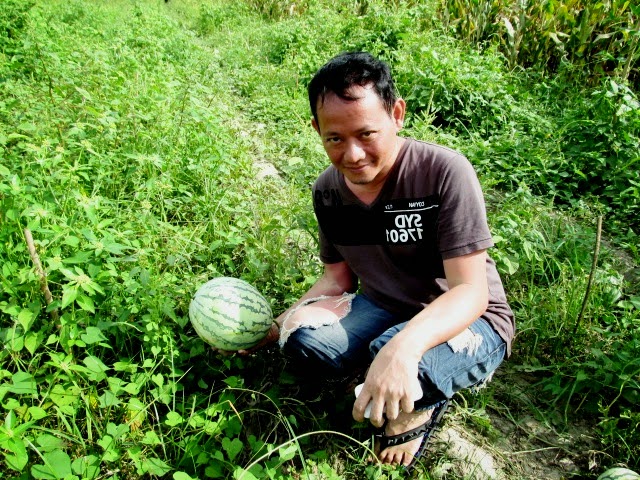I have been to this place about three times already as part of half-day city tour offered by travel agency where I booked my hotel. It was not my first time to travel Bangkok but since it was part of the deal so I joined and might as well check what is new in this place.
What I like in this place is that it was isolated (you need to cross the Chao Praya river to get there) and I'm somewhat a sucker of ruins and heritage sites. I'm always amazed how the pagoda was made, if you check every details of the pagoda it was adorned by broken pieces of Chinese porcelain, how intricate. Our guide told us it was 70meter high.
 |
| My boat ride to Wat Arun |
 |
| Boat ride to the temple |
To give you a little background of Wat Arun:
History: (source: Wikipedia)
 Wat Arun Ratchawararam Ratchawaramahawihan or Wat Arun ("Temple of Dawn") is a Buddhist temple (wat) in Bangkok Yai district of Bangkok, Thailand, on the Thonburi west bank of the Chao Phraya River. The temple derives its name from the Hindu god Aruna, often personified as the radiations of the rising sun. Wat Arun is among the best known of Thailand's landmarks and the first light of the morning reflects off the surface of the temple with pearly iridescence. Although the temple had existed since at least the seventeenth century, its distinctive prang (spires) were built in the early nineteenth century during the reign of King Rama II
Wat Arun Ratchawararam Ratchawaramahawihan or Wat Arun ("Temple of Dawn") is a Buddhist temple (wat) in Bangkok Yai district of Bangkok, Thailand, on the Thonburi west bank of the Chao Phraya River. The temple derives its name from the Hindu god Aruna, often personified as the radiations of the rising sun. Wat Arun is among the best known of Thailand's landmarks and the first light of the morning reflects off the surface of the temple with pearly iridescence. Although the temple had existed since at least the seventeenth century, its distinctive prang (spires) were built in the early nineteenth century during the reign of King Rama II
Mythology
The central prang symbolises Mount Meru of the Hindu cosmology. The satellite prang are devoted to the wind god, Phra Phai. The demons (yaksha) at the entranceway to the ubosot are from the Ramakien. The white figure is named Sahassa Deja and the green one is known as Thotsakan, the Demon Rāvana from Ramayana. Travel Wat Arun can be easily accessed through the Chao Phraya River, and ferries travel across the river towards the Maharaj pier. For the foreigners, the temple charges an entrance fee of 50 baht (as of March 2013). Wat Arun figures in one of Thailand's most colourful festivals, the Royal Kathin and the king travels down in the Thai royal barge procession to present new robes to the monks after their three-month lent period.
 |
| The two demons/ guardians |
Inside the place was a beautiful well-manicured gardens taken cared of by the monks:
Architecture (sourced from Wikipedia)
 The main feature of Wat Arun is its central prang (Khmer-style tower) which is encrusted with colourful porcelain. This is interpreted as a stupa-like pagoda encrusted with coloured faience. The height is reported by different sources as between 66.8 m (219 ft) and 86 m (282 ft). The corners are surrounded by four smaller satellite prang. The prang are decorated by seashells and bits of porcelain which had previously been used as ballast by boats coming to Bangkok from China.The presiding Buddha image, cast in the reign of Rama II, is said to have been moulded by the king himself. The ashes of King Rama II are interred in the base of the image.
The main feature of Wat Arun is its central prang (Khmer-style tower) which is encrusted with colourful porcelain. This is interpreted as a stupa-like pagoda encrusted with coloured faience. The height is reported by different sources as between 66.8 m (219 ft) and 86 m (282 ft). The corners are surrounded by four smaller satellite prang. The prang are decorated by seashells and bits of porcelain which had previously been used as ballast by boats coming to Bangkok from China.The presiding Buddha image, cast in the reign of Rama II, is said to have been moulded by the king himself. The ashes of King Rama II are interred in the base of the image. Construction of the tall prang and four smaller ones was started by King Rama II during 1809-1824 and completed by King Rama III (1824–1851). The towers are supported by rows of demons and monkeys. Very steep and narrow steps lead to a balcony high on the central tower. The circumference of the base of the structure is 234 metres, and the central prang is 250 feet high. The central prang is topped with a seven-pronged trident, referred to by many sources as the "Trident of Shiva". Around the base of the prangare various figures of ancient Chinese soldiers and animals. Over the second terrace are four statues of the Hindu god Indra riding on Erawan. In the Buddhist iconography, the central prang is considered to have three symbolic levels—base for Traiphum indicating all realms of existence, middle for Tavatimsa where all desires are gratified and top denoting Devaphum indicating six heavens within seven realms of happiness. At the riverside are six pavilions (sala) in Chinese style. The pavilions are made of green granite and contain landing bridges.
Construction of the tall prang and four smaller ones was started by King Rama II during 1809-1824 and completed by King Rama III (1824–1851). The towers are supported by rows of demons and monkeys. Very steep and narrow steps lead to a balcony high on the central tower. The circumference of the base of the structure is 234 metres, and the central prang is 250 feet high. The central prang is topped with a seven-pronged trident, referred to by many sources as the "Trident of Shiva". Around the base of the prangare various figures of ancient Chinese soldiers and animals. Over the second terrace are four statues of the Hindu god Indra riding on Erawan. In the Buddhist iconography, the central prang is considered to have three symbolic levels—base for Traiphum indicating all realms of existence, middle for Tavatimsa where all desires are gratified and top denoting Devaphum indicating six heavens within seven realms of happiness. At the riverside are six pavilions (sala) in Chinese style. The pavilions are made of green granite and contain landing bridges.
Next to the prang is the Ordination Hall with a Niramitr Buddha image supposedly designed by King Rama II. The front entrance of the Ordination Hall has a roof with a central spire, decorated in coloured ceramic and stuccowork sheated in coloured china. There are two demons, or temple guardian figures, in front. The murals were created during the reign of Rama V.
 |
| A monk feeding the pigeons |
A word of caution, our guide told us about not getting any souvenir from the temple, he narrates a British tourist who took something from the temple ( a piece of porcelain as a souvenir) when that tourist came back to England, he can't sleep for many weeks and always dreamed of someone who 's asking him to return back what he took, he decided to come back to the temple and returned what he took and never dreamed of it again.































































